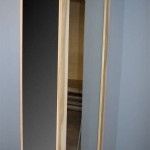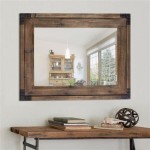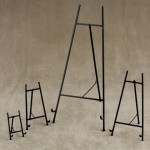The Allure of Vintage Makeup Vanity Round Mirrors
Vintage makeup vanity round mirrors represent more than just reflective surfaces; they encapsulate an era of elegance and meticulous personal grooming. These mirrors, often found as standalone pieces or integrated into vanity sets, possess a timeless appeal that continues to resonate with collectors, interior designers, and individuals seeking a touch of classic charm in their modern lives. Understanding the characteristics, historical context, and practical considerations surrounding vintage vanity round mirrors is crucial for those interested in acquiring or appreciating these artifacts.
The popularity of vintage items stems from a confluence of factors, including a desire for unique, well-crafted objects that stand in contrast to mass-produced contemporary pieces. Vintage vanity mirrors, in particular, offer a sense of history and individuality. Each scratch, imperfection, or design detail tells a story of past ownership and reflects the prevailing aesthetic standards of its time. The materials used, the craftsmanship displayed, and the overall design aesthetic distinguish these mirrors from their modern counterparts, making them highly sought after by those seeking to introduce character and sophistication into their living spaces.
The shape itself, round, lends a softer, more forgiving quality to the reflection. Unlike harsh, angular mirrors, the rounded form can be more flattering and less critical, aligning with the often idealized image of beauty prevalent in earlier eras. Beyond purely functional considerations, the round shape contributes to the overall design aesthetic, often complementing softer, more curvilinear furniture styles common in vintage and antique settings.
Identifying Features of Vintage Vanity Round Mirrors
Differentiating a genuine vintage vanity round mirror from a modern reproduction requires close attention to several key features. The materials used in construction often provide initial clues. Common materials for the frame and base include brass, silver plating, chrome, wood (such as mahogany, walnut, or oak), cast iron, and occasionally, even Bakelite or celluloid, particularly in Art Deco examples. The presence of these materials, especially those less commonly used today, can indicate a vintage origin. The quality of the materials should also be considered. Vintage pieces typically exhibit a higher level of craftsmanship and utilize more durable substances than contemporary imitations.
The style and design of the mirror frame are also crucial indicators. Different eras favored distinct design elements. For instance, an Art Deco mirror might feature geometric shapes, stylized floral motifs, and streamlined forms, while a Victorian-era mirror could incorporate elaborate ornamentation, intricate carvings, and rich finishes. Recognizing these stylistic differences can help to narrow down the age and origin of the mirror. Researching popular mirror designs from specific periods can provide a valuable frame of reference for identification.
Hallmarks, maker's marks, and patent numbers, if present, can provide definitive proof of authenticity and origin. These markings are typically found on the back of the mirror, on the base, or on the frame. Researching these marks can reveal the manufacturer, the date of production, and other relevant information about the mirror's history. However, it is important to note that not all vintage mirrors will have readily identifiable markings, and their absence does not necessarily indicate a reproduction.
Another significant factor to consider is the condition of the mirror itself. While some degree of wear and tear is to be expected in vintage items, excessive damage, such as deep scratches, silvering loss, or significant rust, can detract from the mirror's value and aesthetic appeal. Silvering loss, in particular, is a common issue with older mirrors, resulting in dark spots or a cloudy appearance. However, minor imperfections can often be tolerated as part of the mirror's character and history. The backing of the mirror is equally important. Older mirrors may have wood or metal backings, secured with tacks or glue. Newer mirrors often use cardboard or particleboard. The quality of the backing material can be a telltale sign of age.
The type of glass used will also offer some insight. Older mirrors often used thicker glass, and sometimes even hand-blown glass, which can have subtle imperfections and distortions. Modern mirrors typically use thinner, machine-made glass, which is perfectly uniform and lacks the character of older glass. Examining the edge quality can be helpful as well. Older mirrors are often hand-ground, resulting in a slightly irregular edge, while modern mirrors have a perfectly smooth, machine-cut edge.
Historical Context and Design Styles
Understanding the historical context of vintage vanity round mirrors provides a deeper appreciation for their design and significance. The Victorian era, known for its emphasis on ornate detail and elaborate ornamentation, produced vanity mirrors that reflected this aesthetic. These mirrors often featured heavy frames, intricate carvings, and luxurious finishes, such as gold leaf or silver plating. The mirrors themselves were often surrounded by smaller drawers and compartments for storing cosmetics, jewelry, and other personal items.
The Art Deco period, which emerged in the 1920s and 1930s, represented a dramatic shift away from Victorian excess. Art Deco vanity mirrors embraced geometric shapes, streamlined forms, and a sense of modernity. Common materials included chrome, Bakelite, and mirrored glass. The designs were often simpler and more functional, reflecting the era's emphasis on industrial design and mass production.
Mid-Century Modern design, popular in the 1950s and 1960s, favored clean lines, organic shapes, and a minimalist aesthetic. Vanity mirrors from this period often featured simple wooden frames, sometimes made of teak or walnut, and a focus on functionality. These mirrors were often integrated into larger vanity units, with ample storage space and a focus on practicality.
Understanding these stylistic distinctions can help to identify the age and origin of a vintage vanity round mirror and appreciate its historical context. By researching the design trends and materials popular during different eras, collectors and enthusiasts can gain a deeper understanding of the mirror's significance and value.
Popular colors and materials also varied by era. For instance, Victorian vanity mirrors often featured dark woods, such as mahogany or walnut, and rich, saturated colors, such as deep reds, greens, and blues. Art Deco mirrors, on the other hand, often incorporated brighter colors, such as turquoise, coral, and gold, as well as materials such as chrome, glass, and Bakelite. Mid-Century Modern mirrors favored natural materials and muted colors, such as wood tones, earth tones, and pastels.
Practical Considerations for Acquisition and Care
Acquiring a vintage vanity round mirror requires careful consideration of several practical factors. The condition of the mirror is paramount, as excessive damage can detract from its value and aesthetic appeal. Examining the mirror for scratches, silvering loss, rust, and other signs of wear and tear is essential. It is also important to assess the structural integrity of the frame and base, ensuring that they are stable and in good repair.
The size and scale of the mirror should also be considered in relation to the intended space. A large, ornate mirror may overwhelm a small room, while a small, simple mirror may get lost in a larger space. Measuring the available space and considering the overall design aesthetic of the room are important steps in selecting an appropriate mirror.
The price of a vintage vanity round mirror can vary widely depending on its age, condition, rarity, and provenance. Researching comparable mirrors online and at antique stores can provide a general sense of market value. It is important to be aware of potential scams and to purchase from reputable dealers or auction houses. Inspecting the mirror in person before purchasing is always recommended, if possible.
Once acquired, proper care and maintenance are essential to preserving the beauty and longevity of a vintage vanity round mirror. Regular cleaning with a soft, damp cloth can help to remove dust and dirt. Avoid using harsh chemicals or abrasive cleaners, as these can damage the mirror's surface and frame. For mirrors with silver plating or gold leaf, professional cleaning may be required to avoid tarnishing or damage.
Protecting the mirror from excessive moisture and direct sunlight is also important. Moisture can cause rust and corrosion, while sunlight can fade the finish and damage the mirror's backing. Storing the mirror in a cool, dry place is ideal. For mirrors that are not in use, covering them with a soft cloth can help to protect them from dust and scratches.
If repairs are necessary, it is often best to seek the assistance of a professional conservator or restorer. Attempting to repair a vintage mirror without the proper knowledge and skills can cause further damage. A professional can assess the damage and recommend the appropriate course of action, ensuring that the mirror is restored to its original condition while preserving its historical integrity.
The integration of a vintage vanity mirror into a modern setting requires some thought. Consider the mirror's style and how it complements the existing décor. A vintage mirror can serve as a focal point in a room, adding character and charm. Juxtaposing a vintage mirror with contemporary furniture can create an interesting and visually appealing contrast. The finish of the mirror's frame should also be considered. A distressed or aged finish can add to the mirror's vintage appeal, while a polished finish can create a more modern look.

Furniture Hq Guide Old Vanity Art Deco Waterfall

Vintage Vanity Set Makeup Table With Round Led Lights Mirror 4 Drawers Organizer

Enchanting White Antique Vanity With Round Mirror And Bench Shabby Chic Dresser Furniture

Vintage Unred 1930s Era Art Deco Waterfall Vanity With Round Mirror Stool

Desktop Makeup Mirror Vanity Vintage Simple Cosmetic Temu

Repurposed Upcycled And Refinished This Amazing Vintage Waterfall Vanity Mirror Chair I M Pinning Anothe Furniture Makeover Diy

Bedroom Vanity Table Set Vintage Oak Wood Makeup Dresser Dressing With Mirror China Furniture Made In Com

Vintage Vanity Makeup Set With Round Lighted Mirror Industrial Dressing Table 4 Drawers And Cushioned Stool Rustic Brown Black Com

Makeup Vanity Round Mirror Stand Vintage Rare Decor W Lights

Vintage Vanity Makeup Set With Round Lighted Mirror Industrial Dressing Table 4 Drawers And Cushioned Stool Rustic Brown Black Com








